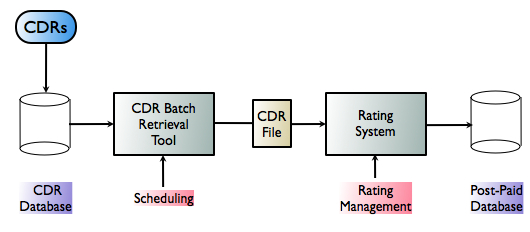23 Charging and Integrating Billing
This chapter explains the Oracle Communications Services Gatekeeper charging functionality and provides an overview of how you can integrate an external billing system.
About Charging
You can select the type of charging to each application service. An application can use one or both of the following types of charging:
-
Content-based charging, which is charging based on the content or value of the service used
-
CDR-based charging, which is charging based on the period of time a service is used (the duration) or the time of day that a service is used
Content-Based Charging
Content or value based charging is used to charge a user based on the variable value of a used service rather than on the duration of the use on flat rates. This can be used, for example, when downloading music video clips or in mobile commerce applications. Services Gatekeeper supports both prepaid and postpaid user accounts.
CDR-Based Charging
Call Data Records (CDRs) are used for charging based either on the duration of use or on access to certain per-use services. Charging for calls is typically based on duration. Per-use might be used, for example, to charge for locating a terminal.
CDR data can be stored in the Services Gatekeeper internal charging database or retrieved in real time by billing and post processing systems through a billing gateway. Retrieving data in real time requires integrating with the billing gateway. See "Billing System Integration" for more information.
Charging data is generated every time an application uses a communication service. The charging data is recorded by the communication service during the period that the application interacts with the network. When the interaction is closed, the communication service stores the charging data as a CDR in the Services Gatekeeper database. If Services Gatekeeper is integrated with a billing gateway, the charging data is sent directly to the billing gateway.
Diameter Charging Support
Services Gatekeeper has specific support for using the Diameter protocol for online (Ro) and offline (Rf) charging. The Parlay X 3.0 Payment communications services can be used for online charging using Diameter. Offline charging can be integrated using the CDR to Diameter module, which converts CDRs generated by Services Gatekeeper into the appropriate format for Diameter charging requests and then sends them on to an offline Diameter server.
Billing System Integration
You can integrate Services Gatekeeper with external billing systems. The billing system can either receive charging data directly or automatically retrieve information from the Services Gatekeeper database. CDRs can be customized to fit the format and behavior requirements of these billing systems. Services Gatekeeper supports integration with the Oracle Communications Elastic Charging Engine and Oracle Communications Billing and Revenue Management products, but can be used with any billing system that supports the Diameter protocol. Billing systems that support offline charging (Diameter Rf) use the Services Gatekeeper CDR module. Billing systems that support online charging (Diameter Ro) use either the Services Gatekeeper credit control interceptors for in-traffic credit checks or the Parlay X 3.0 Payment/Diameter communication service for direct billing.
See "Implementing Diameter Ro Online Charging" or "Implementing Diameter Rf Offline Charging" for information on how to integrate Services Gatekeeper with an online or offline billing system. See "Parlay X 3.0 Payment/Diameter" in Services Gatekeeper Communication Service Reference Guide for details on integrating Services Gatekeeper with direct billing.
Billing Gateways
Real-time settlement of prepaid accounts using CDR-based charging requires integration through a billing gateway. A billing gateway can also be used to support charging of postpaid services.
When integrating through a billing gateway, the billing gateway retrieves the CDRs in real time through an external JMS-based charging listener. Rating, rating management, billing information storage, and prepaid accounts settlement are handled by the billing gateway. The workflow is shown in Figure 23-1.
Figure 23-1 Billing Integration Through a Billing Gateway

Description of ''Figure 23-1 Billing Integration Through a Billing Gateway''
CDR Database
If an application uses postpaid accounts, you can integrate billing by retrieving CDRs that have been stored in the Services Gatekeeper database. When you integrate billing using this method, a CDR batch retrieval tool retrieves the CDRs from the database and stores them in a file. The CDR file is processed by a rating system that transforms it into billing information and then stores it in a postpaid accounts database. The workflow is shown in Figure 23-2.
Figure 23-2 Billing Integration Using a CDR Database

Description of ''Figure 23-2 Billing Integration Using a CDR Database''